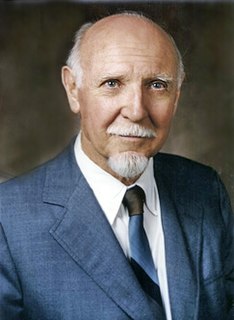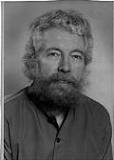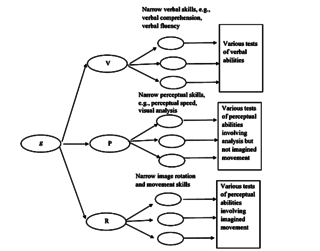
An intelligence quotient (IQ) is a total score derived from a set of standardized tests or subtests designed to assess human intelligence. The abbreviation "IQ" was coined by the psychologist William Stern for the German term Intelligenzquotient, his term for a scoring method for intelligence tests at University of Breslau he advocated in a 1912 book.

Human intelligence is the intellectual capability of humans, which is marked by complex cognitive feats and high levels of motivation and self-awareness. High intelligence is associated with better outcomes in life.
The g factor is a construct developed in psychometric investigations of cognitive abilities and human intelligence. It is a variable that summarizes positive correlations among different cognitive tasks, reflecting the fact that an individual's performance on one type of cognitive task tends to be comparable to that person's performance on other kinds of cognitive tasks. The g factor typically accounts for 40 to 50 percent of the between-individual performance differences on a given cognitive test, and composite scores based on many tests are frequently regarded as estimates of individuals' standing on the g factor. The terms IQ, general intelligence, general cognitive ability, general mental ability, and simply intelligence are often used interchangeably to refer to this common core shared by cognitive tests. The g factor targets a particular measure of general intelligence.
The concepts of fluid intelligence (gf) and crystallized intelligence (gc) were introduced in 1963 by the psychologist Raymond Cattell. According to Cattell's psychometrically-based theory, general intelligence (g) is subdivided into gf and gc. Fluid intelligence is the ability to solve novel reasoning problems and is correlated with a number of important skills such as comprehension, problem solving, and learning. Crystallized intelligence, on the other hand, involves the ability to deduce secondary relational abstractions by applying previously learned primary relational abstractions.

Raymond Bernard Cattell was a British-American psychologist, known for his psychometric research into intrapersonal psychological structure. His work also explored the basic dimensions of personality and temperament, the range of cognitive abilities, the dynamic dimensions of motivation and emotion, the clinical dimensions of abnormal personality, patterns of group syntality and social behavior, applications of personality research to psychotherapy and learning theory, predictors of creativity and achievement, and many multivariate research methods including the refinement of factor analytic methods for exploring and measuring these domains. Cattell authored, co-authored, or edited almost 60 scholarly books, more than 500 research articles, and over 30 standardized psychometric tests, questionnaires, and rating scales. According to a widely cited ranking, Cattell was the 16th most eminent, 7th most cited in the scientific journal literature, and among the most productive psychologists of the 20th century. He was, however, a controversial figure, due in part to false accusations of his friendships with and intellectual respect for white supremacists and neo-Nazis.
Charles Edward Spearman, FRS was an English psychologist known for work in statistics, as a pioneer of factor analysis, and for Spearman's rank correlation coefficient. He also did seminal work on models for human intelligence, including his theory that disparate cognitive test scores reflect a single General intelligence factor and coining the term g factor.
The Kaufman Assessment Battery for Children (KABC) is a clinical instrument for assessing cognitive development. Its construction incorporates several recent developments in both psychological theory and statistical methodology. The test was developed by Alan S. Kaufman and Nadeen L. Kaufman in 1983 and revised in 2004. The test has been translated and adopted for many countries, such as the Japanese version of the K-ABC by the Japanese psychologists Tatsuya Matsubara, Kazuhiro Fujita, Hisao Maekawa, and Toshinori Ishikuma.
The Culture Fair Intelligence Test (CFIT) was created by Raymond Cattell in 1949 as an attempt to measure cognitive abilities devoid of sociocultural and environmental influences. Scholars have subsequently concluded that the attempt to construct measures of cognitive abilities devoid of the influences of experiential and cultural conditioning is a challenging one. Cattell proposed that general intelligence (g) comprises both fluid intelligence (Gf) and crystallized intelligence (Gc). Whereas Gf is biologically and constitutionally based, Gc is the actual level of a person's cognitive functioning, based on the augmentation of Gf through sociocultural and experiential learning.

The Cattell–Horn–Carroll theory, is a psychological theory on the structure of human cognitive abilities. Based on the work of three psychologists, Raymond B. Cattell, John L. Horn and John B. Carroll, the Cattell–Horn–Carroll theory is regarded as an important theory in the study of human intelligence. Based on a large body of research, spanning over 70 years, Carroll's Three Stratum theory was developed using the psychometric approach, the objective measurement of individual differences in abilities, and the application of factor analysis, a statistical technique which uncovers relationships between variables and the underlying structure of concepts such as 'intelligence'. The psychometric approach has consistently facilitated the development of reliable and valid measurement tools and continues to dominate the field of intelligence research.
The Das–Naglieri cognitive assessment system (CAS) test is an individually administered test of cognitive functioning for children and adolescents ranging from 5 through 17 years of age that was designed to assess the planning, attention, simultaneous and successive cognitive processes as described in the PASS theory of intelligence.
Raymond S. Dean was an American psychologist who was the George and Frances Ball Distinguished Professor of Neuropsychology and Professor of Psychology at Ball State University.
Domain-general learning theories of development suggest that humans are born with mechanisms in the brain that exist to support and guide learning on a broad level, regardless of the type of information being learned. Domain-general learning theories also recognize that although learning different types of new information may be processed in the same way and in the same areas of the brain, different domains also function interdependently. Because these generalized domains work together, skills developed from one learned activity may translate into benefits with skills not yet learned. Another facet of domain-general learning theories is that knowledge within domains is cumulative, and builds under these domains over time to contribute to our greater knowledge structure. Psychologists whose theories align with domain-general framework include developmental psychologist Jean Piaget, who theorized that people develop a global knowledge structure which contains cohesive, whole knowledge internalized from experience, and psychologist Charles Spearman, whose work led to a theory on the existence of a single factor accounting for all general cognitive ability.

John Leonard Horn was a scholar, cognitive psychologist and a pioneer in developing theories of multiple intelligence.
Neurodevelopmental framework for learning, like all frameworks, is an organizing structure through which learners and learning can be understood. Intelligence theories and neuropsychology inform many of them. The framework described below is a neurodevelopmental framework for learning. The neurodevelopmental framework was developed by the All Kinds of Minds Institute in collaboration with Dr. Mel Levine and the University of North Carolina's Clinical Center for the Study of Development and Learning. It is similar to other neuropsychological frameworks, including Alexander Luria's cultural-historical psychology and psychological activity theory, but also draws from disciplines such as speech-language pathology, occupational therapy, and physical therapy. It also shares components with other frameworks, some of which are listed below. However, it does not include a general intelligence factor, since the framework is used to describe learners in terms of profiles of strengths and weaknesses, as opposed to using labels, diagnoses, or broad ability levels. This framework was also developed to link with academic skills, such as reading and writing. Implications for education are discussed below as well as the connections to and compatibilities with several major educational policy issues.
Cross-battery assessment is the process by which psychologists use information from multiple test batteries to help guide diagnostic decisions and to gain a fuller picture of an individual's cognitive abilities than can be ascertained through the use of single-battery assessments. The cross-battery approach (XBA) was first introduced in the late 1990s by Dawn Flanagan, Samuel Ortiz and Kevin McGrew. It offers practitioners the means to make systematic, valid and up-to-date interpretations of intelligence batteries and to augment them with other tests in a way that is consistent with the empirically supported Cattell–Horn–Carroll (CHC) theory of cognitive abilities.
The Woodcock–Johnson Tests of Cognitive Abilities is a set of intelligence tests first developed in 1977 by Richard Woodcock and Mary E. Bonner Johnson. It was revised in 1989, again in 2001, and most recently in 2014; this last version is commonly referred to as the WJ IV. They may be administered to children from age two right up to the oldest adults. The previous edition WJ III was praised for covering "a wide variety of cognitive skills".
The following outline is provided as an overview of and topical guide to human intelligence:

Vernon's verbal-perceptual model is a theory about the structure of intelligence proposed by Philip E. Vernon in 1964. It was influenced by the theory of g factor.

The g-VPR model is a model of human intelligence published in 2005 by psychology professors Wendy Johnson and Thomas J. Bouchard Jr. They developed the model by analyzing Gf-Gc theory, John Carroll’s Three-stratum theory and Vernon’s verbal-perceptual model.
Human Cognitive Abilities: A Survey of Factor-Analytic Studies is a 1993 book by psychologist John B. Carroll. It provides an overview of psychometric research using factor analysis to study human intelligence. It has proven highly influential in subsequent intelligence research; in 2009, Kevin McGrew described it as a "seminal treatise". The majority of datasets analyzed in the book were later compiled and made freely available on the Woodcock-Muñoz Foundation Human Cognitive Abilities online archive.






